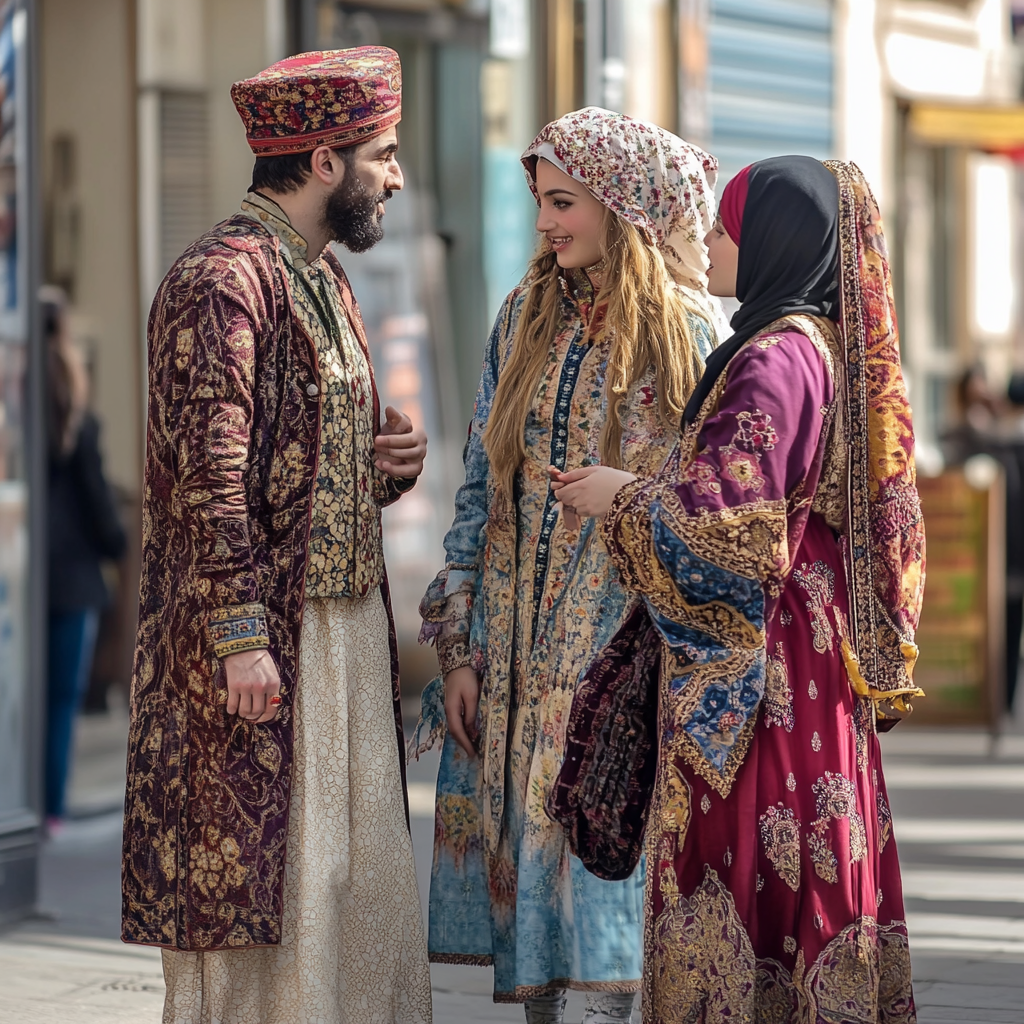Eastern fashion has always been a source of inspiration for world culture and art. A unique combination of ancient traditions, skilled crafts and philosophy, permeating every movement and every element in the image, creates that same timeless style that can still be found today in various parts of the world. The history of the East is not only ancient cities and cultures, but also symbols that are preserved through the centuries, passed on to new generations. In this article we will take a closer look at how the East was able to maintain its elegance and sophistication through the centuries and how these traditions influenced world fashion.
The origins of oriental elegance
In order to understand how the East was able to maintain its elegance through the centuries, we need to go back into history. One of the main factors is philosophy, which permeates every detail of the oriental image. Each element of clothing or accessory carries deep symbolism.. Since ancient times, people living in the East have considered their clothing as a continuation of their inner state, as a way of self-expression and reflection of the soul. This special attitude to appearance has become one of the foundations of the oriental style.
There are several main factors that have contributed to the preservation of oriental elegance through the centuries:
- Materials. Oriental fabrics such as silk, velvet, brocade have always been considered elite and luxurious, and they are still used in creating fashion collections.
- Symmetry and simplicity. Eastern cultures have always valued harmony and symmetry, which is reflected in clothing. This is especially evident in the Japanese kimono, where every fold and line has its own meaning.
- The role of accessories. Accessories in the East often serve not only a decorative function, but also a symbolic one. These can be amulets, jewelry, headdresses that emphasize the status and aesthetic taste of the owner.
- Colors and patterns. Each color in the East has its own meaning, and its use in clothing has always been associated with a certain philosophy and culture. Red, gold, green – these colors symbolize not only beauty, but also energy, wealth and prosperity.
- Hiding and Revealing. In the East, elements of mystery have always been valued. Unlike more open and free Western styles, oriental clothing often covered the body, while leaving room for imagination, which gave the images a special elegance and charm.
These features became the basis not only for the traditional oriental style, but also for world fashion, which actively borrowed elements of the East.
The influence of traditional fabrics on modern looks
Fabrics have always played an important role in creating an image and establishing a connection between the inner world and the outside. In the East The art of textile production has always been associated with high technology, craftsmanship and aesthetics. Fabrics used in the East were distinguished by their luxury and durability. Chinese silk, Japanese kimono-satin, Indian jacquard – all these materials continue to be used in modern fashion collections. Modern fashion and the art of tailoring actively borrow traditional fabrics of the East, combining them with modern production technologies.
Most popular fabricswhich have become an integral part of both traditional and modern fashion are:
- Silk. Used in Chinese, Japanese and Indian traditions, silk is considered a symbol of luxury and high status. Its lightness and airiness give the image lightness and weightlessness.
- Piece. Popular in India and the Middle East, this rich, patterned material symbolizes luxury and elegance. Today, brocade is increasingly found in haute couture collections.
- Velvet. For centuries, velvet remained the privilege of the nobility, especially in Persia and the Ottoman Empire. It perfectly conveys the atmosphere of luxury and grandeur, remaining relevant today.
Almost every designer working in a style inspired by the East uses these materials to bring not only their beauty but also the symbolism associated with them to modern looks. Eastern fabrics become the basis of new trends, combining centuries-old traditions with innovative technologies.
The role of colors and patterns in oriental style
The colors and patterns of the East have always been more than just decorative elements. Each color and design carries a special symbolism and has a specific meaning.. Eastern cultures have long paid attention to how colors and patterns affect human perception. For example, in Chinese culture red is the color of good luck, in Japan it is a symbol of prosperity, and in India it is a symbol of happiness. These meanings have survived to this day and are used in modern collections.
Besides, patterns on oriental clothing have a deep meaning. Geometric shapes, floral motifs, images of animals – all this is not accidental. For example, Japanese kimonos often feature birds and flowers, symbolizing nature, harmony and rebirth. These motifs were used not only in clothing, but also in art, architecture, and jewelry. In modern fashion Oriental patterns are often adapted to create new, unique collections that retain symbolic significance while becoming more universal for a wide range of people.
Eastern minimalism and its philosophy
Eastern minimalism is not just a style, it is an entire philosophy that permeates all areas of life. Eastern cultures have always valued harmony, simplicity and restraint. Oriental minimalism in clothing is embodied in the simplicity of silhouettes, the absence of unnecessary details and accents on natural materials. This is an approach that aims to ensure that every movement, every gesture is harmonious and restrained. Style elements such as wide sleeves, high collars, long dresses and kimonos are not just functional, but also symbolic.
This philosophy is reflected in modern design. Designers inspired by the East often choose simple but elegant lines, avoiding bright or flashy details. This minimalism, when even one element can be significant and expressive, has become an integral part of modern fashion trends. Oriental elements, such as kimonos, dresses with straight lines and loose silhouettes, add special sophistication and elegance to the images.
Modern adaptations of oriental traditions in fashion
Every year more and more designers turn to Eastern traditions for inspiration. Modern collections, filled with oriental motifs, use both clothing items and accessories inspired by ancient cultures. Today, eastern traditions are being adapted to create new, modern images., while maintaining its unique symbolism. Chinese silk, Japanese kimono and Indian brocade – all these elements find their place in the fashion collections of world fashion houses such as Chanel, Dior, Alexander McQueen.
What is important is that adapting Eastern traditions does not mean completely copying them. Modern designers often modify traditional elements to make them more suitable for Western sensibilities. However, the very spirit of the East – restraint, elegance, attention to detail – remains unchanged. Many elements such as patterns, colors, shapes are used in the context of global fashion, which helps the East maintain its relevance in modern trends.
The East has always remained an inexhaustible source of inspiration for great designers. For them, the East is not only style, but also a philosophy of life, harmony and sophistication, which they strive to convey through their collections. Today, many world designers are actively drawing inspiration from oriental traditions, which helps create unique, expressive and at the same time elegant images..
Name of such designers as John Galliano, Vivienne Westwood, is always associated with the influence of the East in their works. This is especially evident in collections that combine elements of oriental decor, silhouettes and fabrics. The East, as an inexhaustible source of inspiration, continues to inspire the creation of collections.
East, with its deep philosophy, cultural traditions and refined art, never ceases to amaze the world with its timeless elegance. Maintaining constant features such as attention to detail, the use of natural materials and the symbolic meaning of each item of clothing, the East continues to influence global fashion. Inspired by oriental sophistication, modern designers create unique collections that preserve the harmony and aesthetics of past eras.
This style, built on eternal principles, is easily adapted to modern realities. The East will continue to serve as a source of inspiration for people seeking to create a stylish and harmonious image. It is thanks to this preservation of age-old traditions that the East remains relevant and in demand, influencing art, culture and fashion around the world.
Oriental style remains relevant due to its deep philosophy, sophistication and elegance, which have been preserved through the centuries. Designers continue to draw inspiration from these traditions, adapting them for modern times, allowing the East to retain its uniqueness and appeal.
Modern collections often use elements of oriental fashion such as Chinese silk, Japanese kimonos, Indian brocade and various patterns symbolizing harmony, prosperity and happiness. These elements make it possible to maintain a connection with traditions, but at the same time create modern, unique images.

